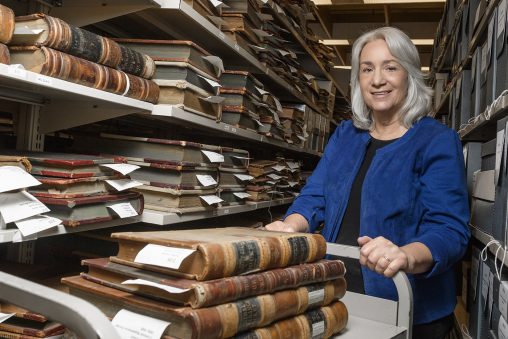
Dawne Dewey, head of the Wright State Special Collections and Archives, which is running a $6.5 million fundraising campaign to create the Wright State University Archives Center.
Nine-year-old Annabelle Marcinek is interested in learning about sisters — the sisters of famous brothers. When she wanted to know more about Katharine Wright, the younger sister of aviation pioneers Wilbur and Orville Wright, she and her mother, Susan, traveled from their Brooklyn, New York, home to Wright State University’s Special Collections and Archives.
At Wright State, Annabelle was able to see Katharine Wright’s report cards, personal letters, grade school autograph album, photographs and even the pressed flower collection that Wright created in 1891.
Annabelle first learned about Wright after reading about her on the Facebook page for the website A Mighty Girl.
“My mom showed me an entry about Katharine Wright and it had the photo of Katharine flying with her dress tied down with a rope,” Annabelle recalled.
As Annabelle did more research on the sisters of famous brothers, she noticed a trend — sisters not being recognized for their contributions to their brothers’ success.
“No one does it alone,” said Annabelle. “Famous people always have help, but we don’t usually know the whole story.”
By reading, touching and exploring the personal mementos of Katharine Wright, Annabelle was able to discover the story of the young girl and later, the woman, who helped support two of the greatest innovators of the 20th century.
“Annabelle liked her autograph book the best, because Katharine was around Annabelle’s age when she had it,” said Annabelle’s mother, Susan. “She also made a connection with Katharine’s plant collection, because Annabelle enjoys identifying plants in nature when we travel and even has her own journal. It got us talking about the things we save and what it will tell people about us.”
Annabelle gave her first visit to Special Collections and Archives two thumbs up. “It was kind of scary at first because I had never been there before,” she said, “but it was fun once I saw all the cool things Dawne (Dewey, head of Special Collections and Archives) set aside for us.”
Annabelle’s mom was just as pleased with their experience. “Dawne made it so easy, because she knew so much about the subject and did lots of digging for us,” said Susan. “She helped bring Katharine to life for us. We’ll be talking about our trip to Dayton for a long time.”
For more information or to make a gift to the Wright State University Archives Center, visit wright.edu/give/archives.
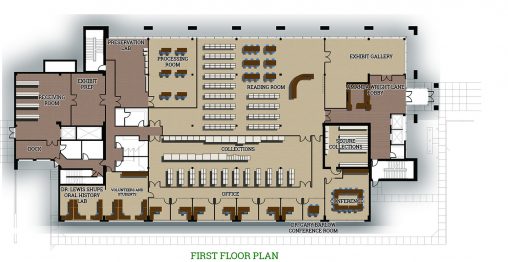
Discover Your Story will transform the former corporate headquarters of the Wright-Patt Credit Union at 2455 Presidential Drive into the new home of Special Collections and Archives.
The Marcineks aren’t the first people to be touched by the timeless treasures within Wright State’s Special Collections and Archives.
From journalists to genealogists, authors to filmmakers, teachers to school children of all ages, more than 4,000 individuals are served annually by Special Collections and Archives, either in person or online.
People come to Wright State from all corners of the globe to see the largest Wright Brothers Collection in the world, including Pulitzer Prize-winning author David McCullough and Academy Award-winning actor, producer and director Tom Hanks. McCullough utilized the collection when he was researching his book “The Wright Brothers.”
While the Wright Brothers Collection is certainly one of the cornerstones of Special Collections and Archives, the depth and breadth of materials go far beyond the personal papers, diaries, photographs and memorabilia of the Wright family. The university houses one of the premier aviation history archives in the country, with more than 400 collections on the history of aviation worldwide.
Even its vast collections on aviation barely scratch the surface of everything Special Collections and Archives has to offer. From first-edition works by African American poet and Dayton native Paul Laurence Dunbar to the archives of the Dayton Daily News, religious history to women’s history, local government records to the records of almost every major arts organization in Dayton, the history of the region, state, nation — even the world — is available for visitors to read, touch, and explore.
For Wright State University graduates Ann and Rob Weisgarber, a recent visit to Special Collections and Archives brought back favorite memories from their childhoods and adolescence.
The Weisgarbers browsed through scrapbook after scrapbook of newspaper clippings on the Dayton Gems hockey team and photos of holiday displays in the former Rike’s department store in downtown Dayton.
For Ann, that journey down memory lane helped her relive the whole experience of getting dressed up, taking the bus downtown, meeting Santa Claus and having lunch in the department store’s restaurant.
“It brought that all back,” she said. “With that comes great pride for the community. It’s people’s lives that have been preserved here. It’s very touching to come here.”
While their visit elicited many happy memories of years gone by, the Weisgarbers were saddened and startled to see how the vast stories of the past have been crammed into such a small, constricting space.
“It’s so crowded that you lose sight of what’s here,” said Rob.
Bursting at the seams
On the fourth floor of the Paul Laurence Dunbar Library, Dawne Dewey loves to walk the stacks. Aisle after aisle of shelves, crammed with boxes as far as the eye can see. Boxes where the stories live.
Stories about two brothers from Dayton who made the first flight and forever changed the world. Stories of trailblazers — like Dayton Daily News founder James M. Cox and famed inventors Charles F. Kettering and Ermal Fraze — who helped make Dayton the cradle of innovation. Stories of the men, women and children who shaped the history of the Miami Valley.
But Dewey, head of Special Collections and Archives, and her team of archivists are quickly running out of space for all of those boxes, and most importantly, the stories they contain.
Special Collections and Archives has come a long way since 1967, when the family of former Ohio governor and Dayton Daily News founder James M. Cox decided to donate his manuscript collection to Wright State.
Fifty years later, Special Collections and Archives is now the home to more than 1,000 local and regional history collections and more than 20,000 books and journals. It is bursting at the seams.
Even worse, the timeless treasures of the past are scattered between two separate buildings on the Wright State campus — an open area on the top floor of the Dunbar Library and the basement of the Medical Sciences Building.
“The two buildings are about a five-minute walk apart,” said Dewey. “While we appreciate the exercise, it would be much better to have the archives in one location.”
Dewey’s dream may finally come true. In 2017, the university launched a $6.5 million fundraising campaign to create the Wright State University Archives Center.
Discover Your Story: The Campaign for the Wright State University Archives Center will transform the former corporate headquarters of the Wright-Patt Credit Union at 2455 Presidential Drive into the new home of Special Collections and Archives.
The Archives Center would almost triple the space for the university’s world-renowned collections — from 12,000 square feet scattered across two buildings to nearly 30,000 square feet in one central location.
“Our new home, directly across from campus, will also give us great visibility from Colonel Glenn Highway and dramatically improve public access and outreach efforts,” said Dewey.
The Discover Your Story campaign is being spearheaded by co-chairs Amanda Wright Lane, great grandniece of the Wright brothers, and McCullough.
“The vision for relocating Special Collections and Archives is to create a whole new visitors’ experience and reach a much broader audience with our world-class collections,” Wright Lane said. “While the facility and staff will still be dedicated to the traditional work of processing, preserving and archiving important historic narratives, this beautiful new home will allow our team to share stories, organize exhibits and teach as they have never been able to before.”
The proposed Wright State University Archives Center will include:
- A reading room where students, scholars and visitors may examine historic materials in an up-close-and-personal way
- An exhibit gallery housing rotating exhibitions that highlight the depth and breadth of Wright State’s collections
- A conference room for lectures, meetings and special events
- A classroom to welcome area school children and students from Wright State’s public history graduate program
- An oral history recording and teaching lab where students, faculty, researchers and the community can record their stories
- A media lab for listening and viewing oral histories and watching original film footage
- A preservation lab, processing room, clean room and exhibit prep room that will give staff the tools and space they need to adequately care for the history of the Dayton region
The facility will also provide the proper storage and climate control to preserve historic materials. And it will serve as a learning laboratory for students in Wright State’s graduate program in public history, where future archivists, preservationists and museum curators get hands-on experience in preserving and protecting priceless photographs, manuscripts, and records.
“Wright State’s Special Collections and Archives deserves more space,” McCullough told guests at the Discover Your Story campaign launch event. “It deserves more attention. It deserves more care as time goes on. And as it increases in space, so will the collections.”
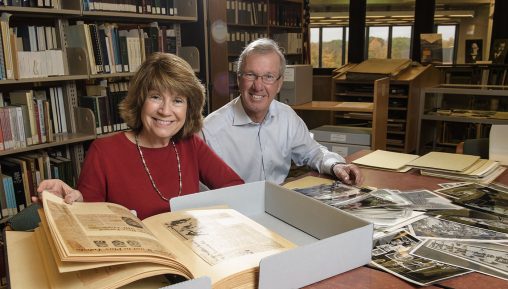
Wright State graduates Ann and Rob Weisgarber were among the first donors to support the Discover Your Story campaign.
Creating the dream
The Wright State University Archives Center will only become a reality if the necessary funds are raised. Rebecca Cole, vice president for advancement and president of the Wright State University Foundation, is well aware of the daunting task that lies ahead.
“The university has already made a major investment by purchasing the former Wright-Patt Credit Union headquarters,” said Cole. “We are now looking to alumni, friends, foundations, corporations and organizations to make this project happen.”
Current estimates project that it will cost approximately $6.5 million to renovate the new space and create an environment with the appropriate light, temperature and humidity control.
“We must raise all of the $6.5 million and have all of the funds in hand before we can begin renovating our new home,” Cole said.
While raising the money will be no easy feat for Cole and her fundraising team, failure is not an option. There is just too much at stake.
“We must make certain that our stories are not lost, that the treasures of our past are protected and that they exist for current and future generations to discover,” said Cole.
Rob and Ann Weisgarber are among the first donors to support the Discover Your Story campaign.
For Ann, an award-winning novelist of historical fiction, the project has personal significance. The Galveston, Texas, resident has utilized the resources of archives across the country while researching her books.
“All three of my books have been research based,” she said. “Almost every chapter is the result of discovering something in an archive. I can write an entire scene around the tiniest thing I found in an archive. Something in a display will just hit me that just triggers a whole chapter in a book.”
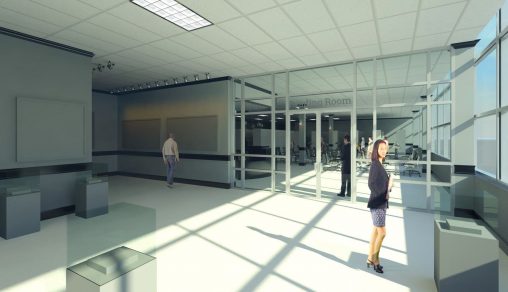
Artist rendering of the entrance to a reading room, where students, scholars and visitors may examine historic materials.
Rob was on board with supporting the Discover Your Story campaign after just one visit to his alma mater’s Special Collections and Archives.
“If you come and see it, you’ll get excited about it and you’ll want to get involved,” he said. “If you get involved, you will find that it will touch you in a lot of ways. And you will see a lot of ways that the archives have a connection to your life. It’s a way to bring history to life.”
For Wright Lane, the new Archives Center will provide the public unprecedented access to Wright State’s one-of-a-kind treasures. It will be a place where people of all ages can learn about their ancestors, discover their family history and explore the power of the past.
“We want Pulitzer Prize-winning authors to research their projects with us, just as David McCullough did,” Wright Lane said. “But just as important, we want the community to bring their book clubs and grandchildren here to discover their stories.”

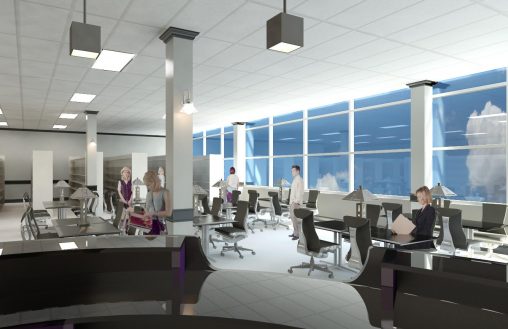
 Milling around
Milling around  Wright State recognizes Nursing Professor Kim Ringo for advancing international student success
Wright State recognizes Nursing Professor Kim Ringo for advancing international student success  Wright State honors graduating students for distinguished doctoral dissertations
Wright State honors graduating students for distinguished doctoral dissertations  Top 10 Newsroom videos of 2025
Top 10 Newsroom videos of 2025  Museum-quality replica of historic Hawthorn Hill donated to Wright State
Museum-quality replica of historic Hawthorn Hill donated to Wright State 